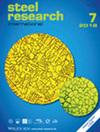The Use of Secondary Metallurgy Slag as Soil Corrective in Agriculture: Approval of Their Application in Italy
IF 1.9
3区 材料科学
Q2 METALLURGY & METALLURGICAL ENGINEERING
引用次数: 0
Abstract
Among the steelmaking slag, secondary metallurgy slag (SMS) is the most problematic to be recycled. Several attempts to recover such slag as lime replacement, slag flux, pozzolanic materials have been made for long time with pros and cons. However, the amount of recyclable slag is limited and often their employment requires higher energy demand than traditional materials. Nevertheless, the use of SMS in agriculture is poorly or never considered. In this article, the legal and technical evaluation of SMS as raw material for fertilizers production is investigated. Compliance of technical specification, toxic metals concentration, and leaching behavior allows to confirm the technical feasibility of SMS use as a raw material for fertilizers manufacture. Both from the literature data and the experimental results on 16 industrial SMS samples, the requirements for calcium‐magnesium‐sulfur‐based fertilizers, soil correctives and for sanitizing agricultural sewage sludge, appear fully satisfied. The CaO concentration in SMS (35–60 wt%) is abundantly higher than the requirements (≥15 wt%) and CaO is present in most part as water‐soluble complexes such as calcium aluminates (70 wt%), silicates (10 wt%), and sulfide (4 wt%). The pH of the SMS samples leachate is comparable to that of fresh lime (12.35 vs 12.46), highlighting a better behavior for sewage sludge sanitation with respect to limestone (9.98). The measured toxic metals and leachate elements concentration over the corresponding admittable threshold are always lower than 0.5 and 1.0 (mg kg在农业中使用二次冶金炉渣作为土壤改良剂:意大利对其应用的认可
在炼钢渣中,二次冶金渣(SMS)是最难回收利用的。长期以来,人们已多次尝试回收此类炉渣作为石灰替代品、炉渣助熔剂和水青石材料,但各有利弊。然而,可回收炉渣的数量有限,而且与传统材料相比,使用这些材料往往需要更多的能源。然而,人们很少或从未考虑过在农业中使用 SMS。本文对 SMS 作为肥料生产原料的法律和技术评估进行了研究。通过对技术规范、有毒金属浓度和浸出行为的合规性分析,确认了将 SMS 用作肥料生产原料的技术可行性。从文献数据和 16 个 SMS 工业样品的实验结果来看,完全符合钙镁硫肥、土壤改良剂和农业污水污泥消毒的要求。SMS 中的氧化钙浓度(35-60 wt%)远远高于要求(≥15 wt%),氧化钙大部分以水溶性复合物的形式存在,如铝酸钙(70 wt%)、硅酸盐(10 wt%)和硫化物(4 wt%)。SMS 样品渗滤液的 pH 值与新鲜石灰的 pH 值相当(12.35 对 12.46),与石灰石的 pH 值(9.98)相比,污水污泥的卫生性能更好。对于石灰材料来说,所测得的有毒金属和渗滤液元素浓度超过相应的容许阈值总是低于 0.5 和 1.0(毫克千克-1/毫克千克-1)。最后,根据这些结果,意大利肥料法规正式批准使用 SMS 作为土壤改良剂。
本文章由计算机程序翻译,如有差异,请以英文原文为准。
求助全文
约1分钟内获得全文
求助全文
来源期刊

steel research international
工程技术-冶金工程
CiteScore
3.30
自引率
18.20%
发文量
319
审稿时长
1.9 months
期刊介绍:
steel research international is a journal providing a forum for the publication of high-quality manuscripts in areas ranging from process metallurgy and metal forming to materials engineering as well as process control and testing. The emphasis is on steel and on materials involved in steelmaking and the processing of steel, such as refractories and slags.
steel research international welcomes manuscripts describing basic scientific research as well as industrial research. The journal received a further increased, record-high Impact Factor of 1.522 (2018 Journal Impact Factor, Journal Citation Reports (Clarivate Analytics, 2019)).
The journal was formerly well known as "Archiv für das Eisenhüttenwesen" and "steel research"; with effect from January 1, 2006, the former "Scandinavian Journal of Metallurgy" merged with Steel Research International.
Hot Topics:
-Steels for Automotive Applications
-High-strength Steels
-Sustainable steelmaking
-Interstitially Alloyed Steels
-Electromagnetic Processing of Metals
-High Speed Forming
 求助内容:
求助内容: 应助结果提醒方式:
应助结果提醒方式:


